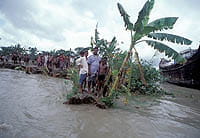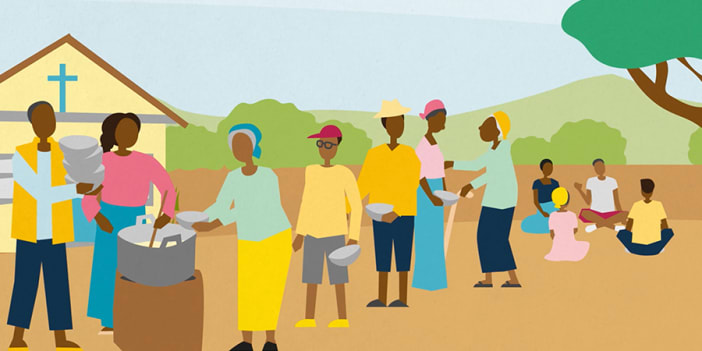
Articles
Flood-related disasters in South Asia
The deltas of the Ganges and Brahmaputra rivers in South Asia flood on a seasonal basis. The flooding keeps the soil fertile because the rivers deposit silt which forms fertile soil each year
2003 Available in English, French, Spanish and Portuguese

From: Learning from disaster – Footsteps 56
Advice on how communities can prepare for the unexpected

Photo: Jim Loring/Tearfund
The deltas of the Ganges and Brahmaputra rivers in South Asia flood on a seasonal basis. The flooding keeps the soil fertile because the rivers deposit silt which forms fertile soil each year. Partly because of the flooding, it is one of the most densely populated areas of the world with millions of people in Nepal, Northern India and Bangladesh depending on the rivers and fertile soils for their livelihoods.
However, in recent years these floods have become very destructive. This is partly due to deforestation in the Himalayas and to the effects of global warming. 1998 was a particularly bad year – 4,500 people died due to flooding in Bangladesh alone. The impact of flooding is serious due to the high population density, lack of flood control or warning systems and because the low-lying land at highest risk is occupied by the poorest people.
The damage caused by severe flooding includes whole villages washed away, agricultural land made useless, crops destroyed and the loss of human life and livestock. Survivors face water-borne diseases, malnutrition, homelessness and the loss of their income.
The Cyclone Preparedness Programme (CPP)
The CPP programme is responsible for sharing information about cyclones in Bangladesh. Bangladesh has the worst record of cyclones in the world, affecting some 11 million people in low-lying coastal areas. The CPP works in 11 districts in the coastal area, covering about 3,500 villages. Thanks to a large network of cyclone shelters built by the Red Crescent and the government, the CPP is able to evacuate large numbers of people. It aims to:
-
issue cyclone warning signals to all people
-
help people reach shelter
-
provide first aid to people injured by a cyclone
-
work with the government of Bangladesh on a disaster preparedness plan
-
build up public awareness and community capacity.
Key features of the programme
- It is a huge, yet community-based project.
- It involves close co-operation between the government, the Red Crescent and the International Federation of the Red Cross who fund the CPP programme.
- It makes disaster preparedness part of the daily life of vulnerable people.
The project is based around the commitment of over 32,000 village-based volunteers, organised into teams of 12. Each team includes at least two female volunteers. Volunteers are selected by the villagers themselves, using clear criteria. These teams are crucial in passing on the cyclone warning signals to their communities. They are all equipped with basic warning equipment, including transistor radios to monitor weather bulletins, megaphones and hand-operated sirens to pass on warnings. Two members of each team are trained in first aid. All members have equipment such as ropes, whistles, lifebuoys, first aid kits, and protective clothing such as boots and life-jackets.
The volunteers receive no payment for their work but are helped with travel costs and daily allowances when attending training sessions. All volunteers receive training in cyclone preparedness, followed by refresher courses every five years. Training provides them with the necessary skills and also builds their commitment.
The volunteers organise regular ‘practices’ and demonstrations in their villages. People have produced dramas about storing of emergency rations, safe shelters and basic hygiene. Folk songs about cyclone-awareness have been written and sung to traditional music. Wall paintings, video shows, radio programmes, posters, leaflets, and booklets are some of the other imaginative ways used to pass on the message to schools, fishermen and the communities at risk.
A cyclone in 1991 killed 138,000 people in Bangladesh. The CPP was set up soon after this. When another similar cyclone hit Bangladesh in 1994 about 750,000 people were successfully evacuated and 127 people died. The difference was due to the success of the CPP. A review in 2000 stated that ‘The programme has acquired, over the years, recognition and acclaim from the general public and government authorities. Cyclone warning and the response to it has become part of people’s daily lives.’
Case study adapted from NGO Initiatives in Risk Reduction, Paper No 4 by David Peppiatt. David Peppiatt is Manager of the ProVention Consortium Secretariat, PO Box 372, 1211 Geneva 19, Switzerland. E-mail: [email protected]
Similarly Tagged Content
Share this resource
If you found this resource useful, please share it with others so they can benefit too.

Subscribe to Footsteps magazine
A free digital and print magazine for community development workers. Covering a diverse range of topics, it is published three times a year.
Sign up now - Subscribe to Footsteps magazine




